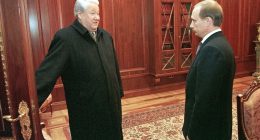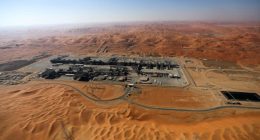WARSAW – It is a nightmare scenario: clouds of radioactive contamination spreading high into the atmosphere and sweeping hundreds of miles across Europe after munitions strike a nuclear reactor in Ukraine. As the world scrambles to respond to the environmental crisis, accusations of deliberate sabotage fly back and forth, setting the stage for a direct confrontation between Russia and NATO.
While it would be comforting to imagine this scenario as far-fetched – a bit of hyperbolic hysteria – so long as fighting continues around the Zaporizhzhya Nuclear Power Plant in southeastern Ukraine there is ample cause for concern that a miscalculation or deliberate action by Russian or Ukrainian military forces could result in a disaster with global impact and environmental damage that could last centuries.
And even as officials in Moscow and Kyiv trade accusations about who is responsible for multiple instances of shelling in and around the sprawling complex – the largest nuclear power plant in Europe – global leaders are issuing increasingly dire warnings about impending nuclear catastrophe, while hawks in Russia and in NATO members say such an event could lead to a wider war.
“ANY deliberate damage causing potential radiation leak to a Ukrainian nuclear reactor would be a breach of NATO’s Article 5,” wrote one British lawmaker, referring to the “collective self-defense” clause that permits the alliance’s members to employ military force to defend each other.
As an emergency session of the UN Security Council gets underway Tuesday afternoon in New York to discuss the power plant, both Ukraine and Russia continue to say they want to end the crisis – but each claims that the other is preparing to carry out a “false flag” attack and create a nuclear incident. Meanwhile, strikes continue – and while conducting artillery duels near a nuclear power plant may seem like sheer madness, the simple fact is that controlling the facility and the electricity it generates is a key strategic objective for both parties. Neither side can afford to give up the plant, which despite Russian occupation, continues powering Ukrainian homes.
Unfortunately, it is also true that any explosion in a sensitive area of the Zaporizhzhya Nuclear Power Plant – located on the banks of the Dnipro River about 100 miles north of Russian-annexed Crimea – could spread radioactive contaminants across large portions of Europe.
“It is not an exaggeration to state that a stray missile or prolonged artillery strike to either the operational units at the power plant, the spent-fuel cooling ponds or spent-fuel storage facilities could be catastrophic,” says Dr. Lewis Blackburn, a researcher with expertise in nuclear materials and waste management at the Immobilization Science Laboratory, a nuclear engineering initiative at the University of Sheffield.
The power plant’s spent fuel rods contain “high-activity” radioactive isotopes that are generated from nuclear fission, Blackburn tells me. These “isotopes have extremely long half-lifes and could easily be dispersed into the wider environment, should an appropriate vector, i.e. a missile, cause the spent fuel to be compromised, i.e. blown up.”
“There is therefore a risk of significant contamination of vast land areas and risk to the wider environment in the event of an attack on these facilities. Whilst a single explosion may not cause significant damage, a targeted and sustained attack on this infrastructure could be disastrous.”
The spread of ionized radioactive particles is determined by environmental factors such as prevailing winds and moisture in the atmosphere. Ukrainian researchers created a simulation of how the radioactive particles would spread, showing them sweeping into Ukraine’s neighbors, including Poland and the Baltic States, in less than 24 hours.
Such an event would be among the worst nuclear disasters in history, affecting the lives and livelihoods of tens of millions of people in multiple countries: a second Chernobyl or Fukushima, complicated by the fact that a response to mitigate the disaster would take place in an active war zone.
This is why Ukrainian officials and international watchdog agencies have been urging immediate intervention, while Ukraine’s allies have also joined the call for a demilitarized zone around the power plant.
Over the weekend, officials from the United Nations and the International Atomic Energy Agency were in Ukraine as part of concerted multinational diplomacy to access the site. But they have made little progress: with the Russian military in de facto control of the power plant, Moscow must agree to any visit by international inspectors. It hasn’t yet.
“An IAEA visit has been in the works since June and would have already taken place if it were not for the U.N. chief’s interference,” Ivan Nechayev, a spokesman for Russia’s foreign ministry, said at a news briefing in Moscow.
When asked about the current status of a planned mission to the plant, a spokesperson for the IAEA could offer little new information: “The IAEA is in active consultations with all parties regarding its efforts to send an agency mission under the leadership of Director General [Rafael Mariano] Grossi to the Zaporizhzhya Nuclear Power Plant as soon as possible.”
Over the past several weeks, Russia and Ukraine have been trading blame about an impending “provocation” or “terrorist action.” Ukrainian state-owned nuclear power provider Enerhoatom – which runs the power plant, and whose 11,000 employees continue to operate it under the eyes and guns of the Russian occupiers – warned via its official Telegram channel that “a Russian propaganda crew” had arrived at the facility and was filming Russian security services firing on the plant, in order to later blame an attack on Ukraine.
It provided no evidence, and this statement could not be independently verified.
Meanwhile Russia denies it is doing anything that would compromise the security of the facility. “We want to make it clear that Russian troops have no heavy weapons deployed either at the power plant or in areas adjacent to it,” Lieutenant General Igor Konashenkov, the Russian defense ministry spokesman, said last week. “The Russian armed forces are taking all the necessary measures to guarantee the security of the Zaporizhzhya NPP.”
Yet strikes near the power plant and its adjacent facilities continue, with one technician from the plant being killed in a mortar strike on a taxi on Monday, according to the mayor of Enerhodar, the city that surrounds the power plant.
These strikes may be part of ruthless – and increasingly desperate – calculations of economic warfare, which continue to drive a strategy of brinksmanship near the power plant.
A fully functional, safe nuclear power plant is obviously more useful than a damaged one leaking radioactive contaminants. It stands to reason that both Russia and Ukraine would not only prefer to own an intact facility, they would also like to control the electricity that it generates.
As of now, that is not the case. Russia physically controls the Zaporizhzhya Nuclear Power Plant, while Ukraine is still getting the bulk of the energy the facility generates – which is about 20 percent of the country’s entire electrical supply.
The last time the Zaporizhzhya facility was taken offline – in 2014, shortly after Russia invaded Crimea – it caused rolling blackouts across Ukraine. The loss of this energy capacity would have a major ripple effect for Ukraine’s economy, which is already reeling from damaged and destroyed infrastructure, blockaded or occupied ports on the Black Sea, and lost resources such as farmland and metals processing plants.
The Ukrainian government is now dependent on international donors to conduct basic operations, such as pensions payments and healthcare services: the World Bank earlier this month offered $4.5 billion in additional economic assistance for Ukraine to meet “urgent needs created by the war.”
So the diplomatic efforts and blame-game about “shelling” and “provocation” serve to veil the more practical consideration about who can control the power plant’s supply of electricity.
“There’s a macro story about economic warfare, and this is part of it,” said Mick Ryan, a military strategist and retired major general in the Australian Army, who has been a close observer of the war in Ukraine. “Russia is trying to deny Ukraine’s ability to carry out the necessary economic and administrative tasks that allow it to be a sovereign state that runs its own country.”
“To me, it’s who is responsible for and in control of the nuclear power plant that really matters,” said Michael Kofman, the director of the Russia Studies program at CNA, a federally funded research organization based in Virginia that focuses primarily on defense issues. “Consider the nuclear power plant and its future as an important consideration for both sides.”
Control of the power plant is ultimately about controlling the energy that it produces, and Russia would like to have the electricity taken away from Ukraine, to be used exclusively in areas under its control. But what precisely is entailed in transferring the electricity supply generated by the power plant from the Ukrainian power grid, to the power grid supplying Russian-held territory is not something a spokesperson from Enerhoatom was willing to explain, perhaps for obvious reasons.
But there are signs that the Russians are increasing their efforts to do so. One Ukrainian military intelligence source indicated that there had been an increase in the number of technicians from Rosatom – the Russian state-owned nuclear power enterprise – visiting the plant.
And Enerhoatom did offer a few clues in its warning on Telegram:
“Russian occupying forces are planning to stop operating power units in the near future, and disconnect them from the communication lines supplying power to the Ukrainian power system,” Enerhoatom wrote. If the goal of this is to disconnect the power plant from the Ukrainian grid, the next step would be rerouting the electricity it generates, and even replacing its staff with Russian technicians.
There is little reason to think that Russian technicians from Rosatom would have any difficulties in taking over operation of the plant from their Enerhoatom counterparts. The reactors at the Zaporizhzhya Power Plant are a Soviet design – a VVER-1000 pressurized water reactor – used in multiple variations across Russia, according to Blackburn, the nuclear materials and waste researcher.
“Therefore, it is reasonable to assume that, given the Russian state operates many VVER-1000 NPPs [nuclear power plants] domestically, they would be able to export considerable expertise to the Zap site and assume control with, presumably, minimal training,” Blackburn said.
So the issue, then, becomes one of controlling how the reactors connect to the power grid. In the case of the Zaporizhzhya Nuclear Power Plant, this would consist of physical infrastructure such as power lines and transformers, but also Enerhoatom’s control systems, information infrastructure and software.
An effort to disrupt the control systems and subsequently the flow of electricity into Ukraine is likely why Enerhoatom reported the “largest cyberattack” it has ever experienced on Wednesday. The company said the attack had originated in Russia, but was unsuccessful.
If Russia were to decide that it could not retain physical control of the plant, nor successfully transfer the power it generates to territories it controls, it could decide that seriously damaging the facility in order to strike at Ukraine’s economy was a viable strategic option.
A false-flag operation at the power plant would help to achieve this, while giving Russian authorities the ability to deny they were involved should such an action create a nuclear disaster.
Meanwhile, the Ukrainian military has an incentive to attack key nodes of physical infrastructure that might eventually permit the energy from the plant to be rerouted to Russian-occupied territories.
Regaining control of the plant will be a major facet of any Ukrainian operations to retake territory lost to Russia. That will mean more fighting in and around its environs, increasing the chances of a nuclear catastrophe.
There are also signs that Ukraine is increasing its tempo of behind-the-lines attacks to undermine Russian forces in occupied territories. Efforts to target key infrastructure, in addition to military equipment or personnel, is part of this campaign.
“I’m beginning to think that the counteroffensive has been underway for several months and we haven’t really noticed,” Ryan, the Australian military strategist, said. “We are seeing partisans working with Ukrainian special forces, deep precision strikes on ammunition facilities and on headquarters. I wouldn’t call it a stealth offensive, but it is an offensive nonetheless.”
Kofman, the analyst, agrees: “I don’t think that the uptick in attacks in Crimea or in Kherson is a coincidence, I think it’s part of a broader strategy by Ukraine to shape the operating environment. Ukraine’s goal is to degrade Russian military ability in key areas, as well as strike at ground lines of communication in Kherson and Crimea.”
The increase in Ukrainian military attacks in the occupied south also means that Russian forces are taking a more defensive posture to prevent being targeted by partisans, special forces or precision munitions.
Which helps to explain why there are images of Russian vehicles and ammunition now being stored inside critical areas of the Zaporizhzhya Nuclear Power Plant: no sane military commander would order a missile strike against a nuclear reactor.
But expecting sanity to prevail in war is not ideal.
“It’s pretty disturbing. I mean the potential for something awful to happen here is significant. Not deliberate, but through miscalculation,” Ryan said.“The circumstances are ripe for some kind of miscalculation by either side.”
Read More: World News | Entertainment News | Celeb News
RollingStone









